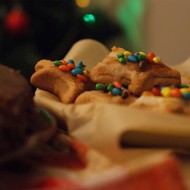
Estonian Christmas Gingerbread
Baking and Desserts | European cuisine
⏳ Time
1 hour
🥕 Ingredients
8
🍽️ Servings
9
Description
Now about the spices. In Estonia, they sell special Christmas spices for gingerbread dough in a ready-made mix. But personally, I only use them in the pastry shop, and at home, for example, I have all these spices separately, in large quantities and of very good quality (cardamom and cinnamon from Jordan, nutmeg from Greece, etc.), so I just mixed them and made the blend myself. Here are the spices that must be included: — cinnamon — ginger — cardamom — nutmeg — black pepper — cloves All spices should be ground into powder. Mix them together, and it's ready! You can make a lot and store it in a separate bag — this mix will be needed throughout December. From my description, this may seem complicated, but in reality, all the steps are quite simple.
Ingredients
- Butter - 3.5 oz
- Sugar - 5.3 oz
- Light Molasses - 2.1 oz
- Honey - 4.2 oz
- Spices - 2 teaspoons
- Wheat Flour - 12.3 oz
- Baking Powder - 1 teaspoon
- Water - 1 fl oz
Step by Step guide
Step 1
Prepare the dough. Beat the butter at maximum speed with a mixer until it turns pale. This will take about 7–10 minutes. Without turning off the mixer, start adding the sugar (50 g) in portions and continue beating — add a third of the sugar, beat for a couple of minutes, another third... and so on.
Step 2
Now you can turn off the mixer and calmly add the molasses, honey, and spices. At home, I replace molasses with soft Muscovado cane sugar — it needs to be soft, meaning it crumbles in the package rather than pouring out, and is slightly moist. This type of sugar is a great substitute for molasses! Here in Estonia, they also replace it with brown sugar syrup — it smells like burnt sugar syrup, thick and sticky, but I haven't encountered that in Russia. As a last resort, if you have neither molasses, nor syrup, nor Muscovado sugar, you can mix regular sugar with condensed milk — we need a sticky consistency.
Step 3
So, to the whipped butter, we added molasses/syrup/sugar, honey, and spices. Beat everything for another minute to mix thoroughly.
Step 4
Now sift the flour and add the baking powder to it. After that, add the flour to the butter mixture and mix thoroughly with a spoon. Mixed? Now just for 5 seconds in the mixer, so the dough comes together. But it's important not to overbeat! Just a quick mix, and you'll see that the dough has formed. It will be crumbly, not a single mass — that's what we need.
Step 5
Next, we can do whatever we want with this dough. For a large gingerbread, I placed all the dough in a round mold 25 cm in diameter and baked it in the oven for 25 minutes at 338°F. If you want cookies or pieces for a gingerbread house, knead the dough thoroughly by hand, work it for about 10 minutes until it becomes elastic, and carefully roll it out with a rolling pin, constantly dusting the table and the rolling pin with flour — it's important that the dough doesn't crumble or stick, but at the same time, no white flour should remain on the finished products, otherwise it will be visible after baking. Excess flour can be brushed off with a pastry brush before sending it to the oven.
Step 6
Bake small gingerbreads for 7–12 minutes (depending on the oven) — watch that they don't become too brown; they should just firm up slightly and rise a bit, so they stay soft and porous inside and won't dry out during storage.
Step 7
Small shapes can be decorated with colorful royal icing or chocolate glaze.
Step 8
With the glaze, it's straightforward — take a lot of sugar (100 g) and a little water (30 ml), bring it to a boil, stirring constantly until the sugar completely dissolves. There's no need to cool this mixture; otherwise, it will thicken. Take a brush, dip it in the glaze, and start spreading it over the surface of the gingerbread with vigorous back-and-forth movements, as if you are a bad painter in a hurry. Very energetically! So that your hand gets tired in a minute. Add more glaze and spread it again. This way, it distributes over the entire surface, and when it starts to set, it will turn white, as is usually the case with gingerbreads.
Step 9
Then just let our gingerbread cool and soak well, and you can have tea!
Cooked This Dish? Share Your Delicious Creation with the Community! 🥰
Snap a photo and let everyone see your culinary masterpiece. Inspire others and showcase your skills!
Users Photos
No photos yet
Leave a Comment
Please log in to leave a comment.